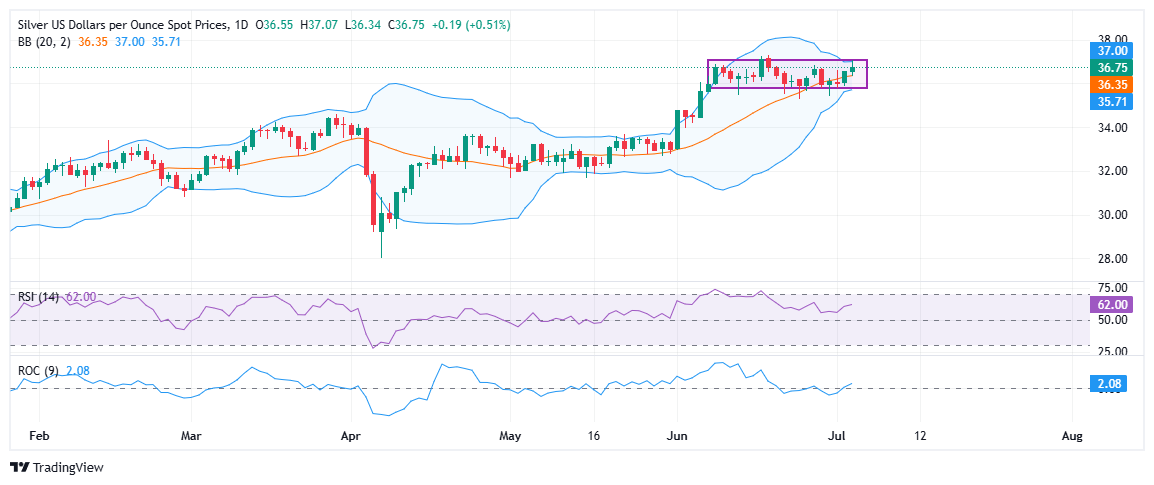Silver Price Forecast: XAG/USD range narrows, eyes bullish breakout
- The metal remains supported above the 20-day SMA, which also aligns with the Bollinger Band midline near $36.35.
- A breakout above the upper Bollinger Band near $37.00 could pave the way for fresh multi-year highs.
- Momentum indicators remain constructive, with the RSI near 62 and the ROC recovering to 2.00.
Silver (XAG/USD) is trading with a modest positive bias on Thursday, holding steady near $36.75 during the American trading session after easing from an earlier high of $37.07. The price briefly approached its June 18 peak of $37.32, a 13-year high, before trimming gains following stronger-than-expected US Nonfarm Payrolls (NFP) data, though the overall technical setup remains supportive for the bulls.

From a technical perspective, the metal remains confined to a tight range. Silver is consolidating above the 20-day Simple Moving Average (SMA), which also serves as the midline of the Bollinger Bands, providing dynamic support around $36.35
The Bollinger Bands are beginning to tighten, suggesting that a potential breakout could be on the horizon. If the price manages to close above the upper band around $37.00, it could spark renewed upside momentum, potentially pushing Silver toward fresh multi-year highs beyond $37.32.
Momentum indicators remain supportive. The Relative Strength Index (RSI) remains elevated near 62, comfortably above the neutral 50 level, indicating strong yet not overextended bullish momentum. Meanwhile, the Rate of Change (ROC) has bounced back into positive territory, last seen around 2.00, reflecting a pickup in buying interest.
On the downside, immediate support is seen at $35.50, marking the lower boundary of the current trading range, followed by the lower Bollinger Band near $35.71. As long as XAG/USD holds above this zone, the broader bullish trend is expected to remain intact.
Silver FAQs
Silver is a precious metal highly traded among investors. It has been historically used as a store of value and a medium of exchange. Although less popular than Gold, traders may turn to Silver to diversify their investment portfolio, for its intrinsic value or as a potential hedge during high-inflation periods. Investors can buy physical Silver, in coins or in bars, or trade it through vehicles such as Exchange Traded Funds, which track its price on international markets.
Silver prices can move due to a wide range of factors. Geopolitical instability or fears of a deep recession can make Silver price escalate due to its safe-haven status, although to a lesser extent than Gold's. As a yieldless asset, Silver tends to rise with lower interest rates. Its moves also depend on how the US Dollar (USD) behaves as the asset is priced in dollars (XAG/USD). A strong Dollar tends to keep the price of Silver at bay, whereas a weaker Dollar is likely to propel prices up. Other factors such as investment demand, mining supply – Silver is much more abundant than Gold – and recycling rates can also affect prices.
Silver is widely used in industry, particularly in sectors such as electronics or solar energy, as it has one of the highest electric conductivity of all metals – more than Copper and Gold. A surge in demand can increase prices, while a decline tends to lower them. Dynamics in the US, Chinese and Indian economies can also contribute to price swings: for the US and particularly China, their big industrial sectors use Silver in various processes; in India, consumers’ demand for the precious metal for jewellery also plays a key role in setting prices.
Silver prices tend to follow Gold's moves. When Gold prices rise, Silver typically follows suit, as their status as safe-haven assets is similar. The Gold/Silver ratio, which shows the number of ounces of Silver needed to equal the value of one ounce of Gold, may help to determine the relative valuation between both metals. Some investors may consider a high ratio as an indicator that Silver is undervalued, or Gold is overvalued. On the contrary, a low ratio might suggest that Gold is undervalued relative to Silver.



